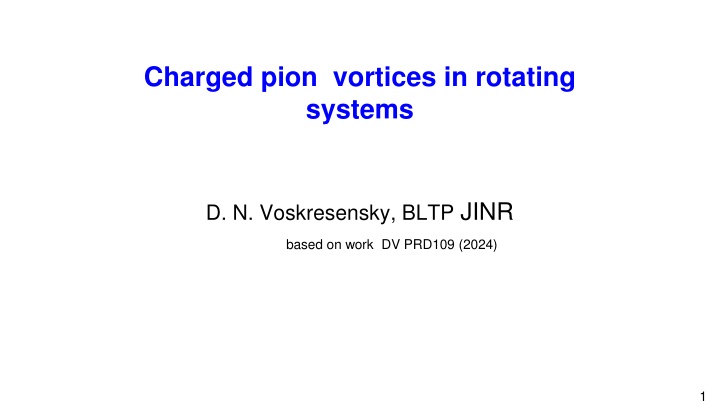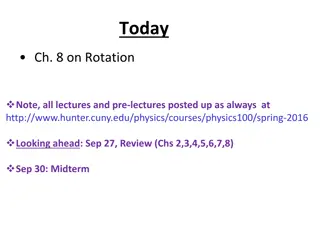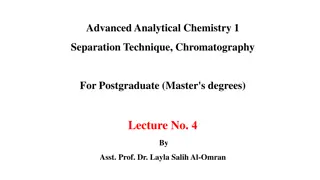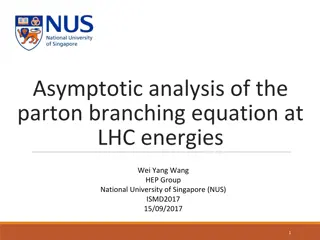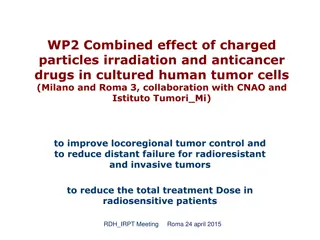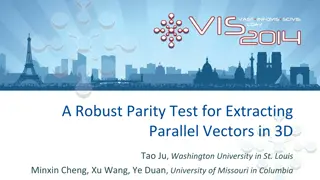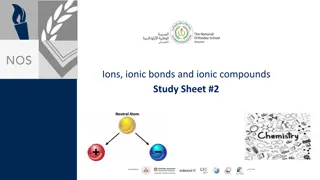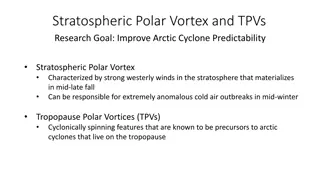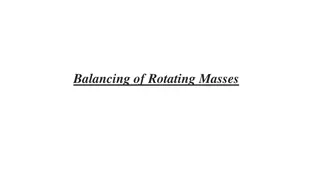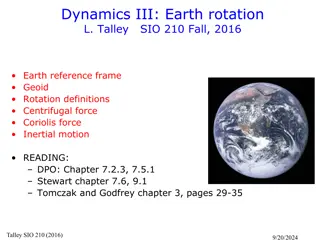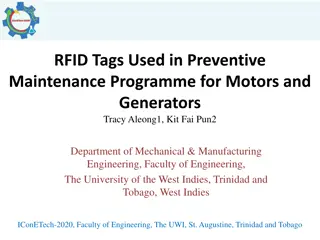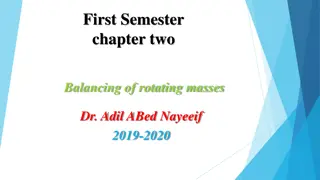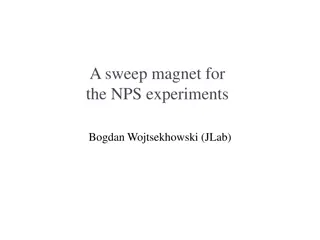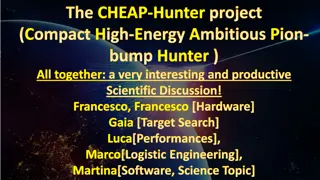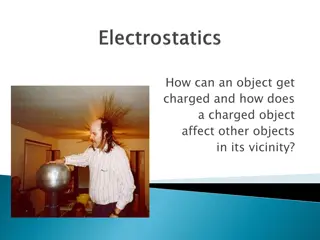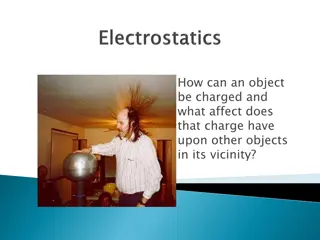Charged Pion Vortices in Rotating Systems: Insights and Consequences
This study explores the intriguing phenomenon of charged pion vortices in rotating systems, discussing their potential appearance in various scenarios, the role of angular momentum, and the manifestation of supervortices. Analysis includes the impact of static electric fields, distribution of vortices, and the absence of self-interaction effects on the fields. The energy of supervortex fields in rotational frames is also investigated.
Download Presentation

Please find below an Image/Link to download the presentation.
The content on the website is provided AS IS for your information and personal use only. It may not be sold, licensed, or shared on other websites without obtaining consent from the author.If you encounter any issues during the download, it is possible that the publisher has removed the file from their server.
You are allowed to download the files provided on this website for personal or commercial use, subject to the condition that they are used lawfully. All files are the property of their respective owners.
The content on the website is provided AS IS for your information and personal use only. It may not be sold, licensed, or shared on other websites without obtaining consent from the author.
E N D
Presentation Transcript
Charged pion vortices in rotating systems D. N. Voskresensky, BLTP JINR based on work DV PRD109 (2024) 1
Plan ``Rotating charged-pion vacuum (storm in empty rotating vessel). Rotating charged pion gas at T=0 (BEC) with a fixed particle number. Some possible consequences for various rotating systems. 2
Charged pion fields in rotation frame Const. Chen et al,PRD93, 2016 rtypic<<1 Let we deal with charged pion field in static electric field eA0lab = V(r ). Seek vortex solutions in cylindric coordinates : is integer winding conserved number, is energy level (Heavy) proton density acts as constant electric potential V(!) Rotation term 3
Rotation & lab. frames , cf. light cone. Treat rot. frame as rot. vessel: internal radius R, External, R>, dz >>R, Two possibilities: (i) rotation frame at =const = rotating vessel with =const. Pion vortex field may appear if in the rotating frame (ii) constant angular momentum Linof rotating rigid vessel, const . Pion vortex may take part of Lin . We treat problem in lab. frame. Rotating pion vortex+ slowed down vessel. Vortex field appears if 4
Angular momentum N is charge of vortex field What is distribution of vortices if they appear? One supervortex or lattice? 5
Fields in absence of self-interaction (=0) in rot. frame KG eq.: cf. KG eq. in static el. field presented in form of Schroedinger eq. from cross-term--Coriolis force term in energy density, centrifugal force term, addition to centrifugal force (rel. ef.) 6
Vortex solution (=0; V=-V0 const) for at >> solution , boundary cond. Level crossing: level (1,1) may cross (1,0) at increasing , for R<1. 7
8 Storm of pion field in empty vessel (rotating vac., =const) Vortex appears Supervortex is produced for any V0 0 at least at ultrarelativistic rotation, R c
Energy of supervortex field in rot. frame coincides with energy gain found via way (ii): For any V<0 at a rapid rotation 1, <0, and there arises instability for creation of -+ pairs in reactions at walls. Antiparticles can be absorbed on walls of vessel, particles form vortex. Tunneling from lower to upper continuum is not required. is limited only by value of Lin of rotating vessel. Amplitude of vortex field is limited only by redistribution of charge. 9
Rotating ideal gas with (dynamically) fixed particle number Now N charged pions are placed in vessel at =0 ! At increasing individual vortices may form lattice. 10
Self-interacting vortex field in rotating frame cf. Gross-Pitaevsky eq. 0 saturates field amplitude, Forx>>1, (x) 1 as for cold atoms and He-II Boundary cond. Interpolation solution But for r=R, was (r=R) 0 Empty rotating vessel (rotating vacuum): as it was in case =0 for c1<<1 but now for arbitrary c1 is limited only by value of Lin of rotating vessel. Amplitude of field is limited by self-interaction 0 11
Nonideal rotating Bose gas with fixed particle number Nonrelativistic rotation as for He-II and cold Bose atoms first vortex with =1. Fluctuations: precession of spirals Rings Supervortex or vortex lines with =1? min. of energy in yields =1 Lattice of vortices each with =1 12
Lattice of vortices Circulation Energy gain due to rigid-body rotation of lattice of vortices mimicking rotation of vessel is triangular lattice is favorable by extra About upper crit. rotat. velocity: In HIC case For c2>1/R separate rotation of vortices or, as in cold at. gases, for > appears supervortex with hole in center (Fischer, Baym 2003) 13
Consequences 14
(a) Rotating supercharged nuclei & nuclearites Consider large size nuclear drop with Nuclear part of energy per nucleon in absence of Coulomb is Ground - level reaches 0 for Z>C/e3 , C ~1, charged pion condensate, interior is charge-neutral Total energy: For small , would be <0 only if effective mass in matter were <32 MeV, Migdal et al, Phys.Rep, 192 (1990) Nuclei-stars, DV1977, there appears supervortex, For rotating object Total energy rotating large nucleus is long-living. Rotation energy Long-living rotating nuclearites (?) is slowly lost only by surface radiation. 15
(b) Pion vortices in heavy-ion collisions Pion fireball: Adamchuck et al STAR 2021 Nuclear fireball: Longer-living rotating+internally rotating pion, K, vortex states in HIC (?) In case of pion gas with fixed particle number Pion supervortex or lattice with Nv~< 10? 16
(c ) Cuper pair gas and pion condensate in neutron stars=pulsars For nn pairing in all pulsars vortex lattice in nucleon superfluid--solid rot. For Vella pulsar distance between vortices in neutron superfluid RL~10-3 cm, similar RL is estimated for pion condensate superfluid in dense neutron star interiors (d) Rotating empty vessel Supervortex with large Thus statement that vacuum (ground state with a field) cannot rotate can be questioned In lab. conditions for a rotating Si-molecular max. ~1010 Hz 17
Conclusion Charged pions can form supervortex with large . In realistic problem is limited by value Lin . BEC at fixed particle number forms lattice mimicking rigid-body rotation, described for > c1 similarly to superfluid cold Bose atoms. Various estimates were done for vortices in various rapidly rotating systems. 18
Non-relativistic limit of weak V(r) and Neglecting 1/c2 quadratic terms On other hand, Galilei transform for Schroedinger eq. yields mag. field (? ) --analogy only for nonrel. & weak H-field. Rot. Two ways to introduce rot.: and yield the same term in energy only for nonrelativistic = weak rotation (!) In relativistic case correct is first way.
Charged pion field in vac. in electric potential well KG eq. in stat. electric field -V, so +/- continua cross for V<Vc= -2 m in when - level reaches =-m Via tunneling from lower continuum, + go to infinity, - condense. In plane capacitor for pions form BEC (!), but probability of creation of pairs is tiny Inside piece of isospin symmetric nuclear matter with R>> 1/m for |V|=Ze2/R> m , Z>(1/e2 -1/e3), - level reaches =0, - are produced innuclear reactions. and - BEC is formed right inside nucleus. No tunneling is required ! So, depending on conditions to create charged pion field is possible either for <0 or <-m
Creation of vortices in uniform constant magnetic field Liu,Zahed,2018 Number of states now for V0 0 For N>1: for H=0 No j2/R2 term ! instead of Then but now for any
Examples of vortex instability in macro-systems (a) Rotating vessel placed inside a charged cylindric capacitor =const. Condition easily fulfilled, for supervortex redistribution of charge inside even neutral rotating vessel Thus statement that vacuum (ground state with a field) cannot rotate can be questioned (b) In magnetic field c decreases. Uniform H inside rotating vessel can be generated if vessel is put inside solenoid, and if vessel walls are charged:
